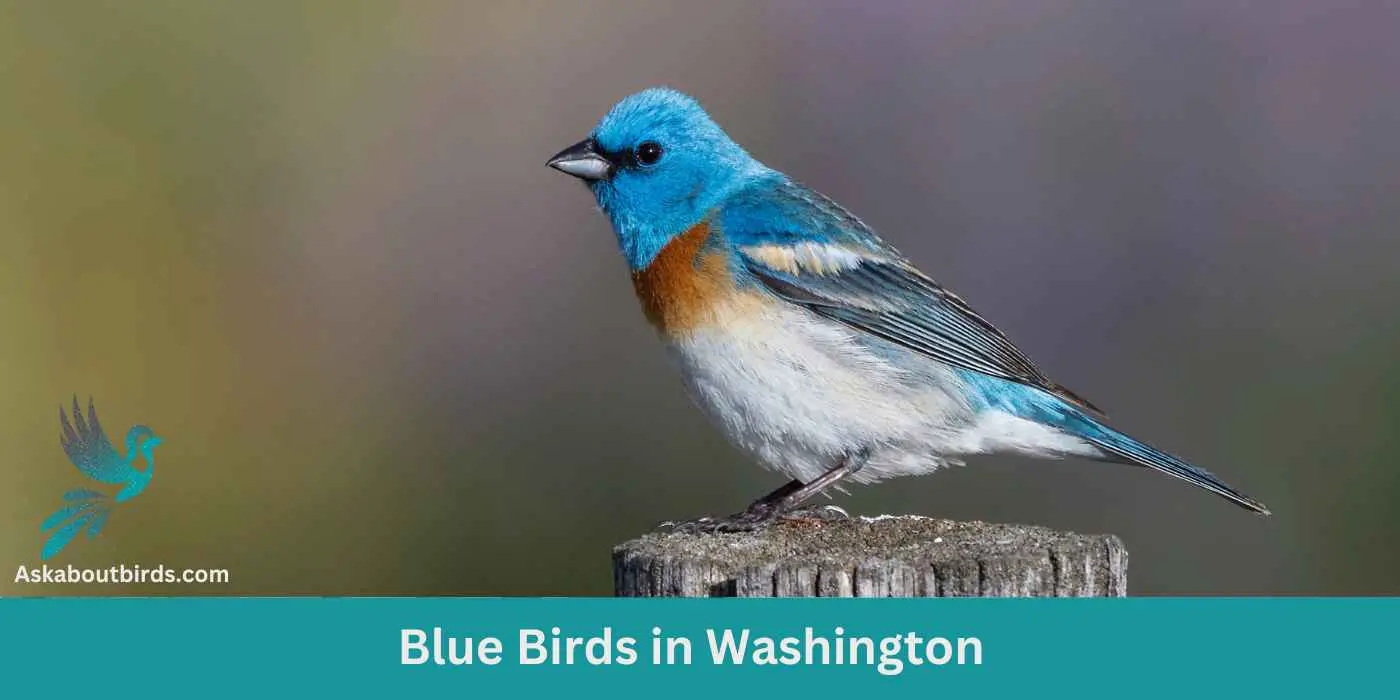Welcome to our comprehensive guide on Blue Birds in Washington! The Evergreen State is not only home to majestic mountains, lush forests, and stunning coastlines, but it also hosts a remarkable diversity of birdlife, including several species of blue birds.
Our Free Photo Guide is designed to help you identify, understand, and appreciate these beautiful creatures in their natural habitats. Whether you are a seasoned birdwatcher or a curious beginner, this guide will provide you with valuable insights and spectacular images of Washington’s blue birds. Let’s embark on this exciting journey together!”
Blue Birds Found In Washington
The diverse geography of Washington State creates a variety of habitats that attract a wide range of bird species. From the coastal regions of the Puget Sound, to the Cascade Mountains, and the semi-arid basins of the Columbia Plateau, each region offers unique ecosystems that are home to different bird populations.
This diversity of habitats, combined with its location on the Pacific Flyway, a major north-south migration route for birds in the Americas, make Washington a hotspot for birdwatching. Numerous species, including various blue birds, find breeding, feeding, and resting grounds across the state, contributing to its rich avian biodiversity.
Eastern Bluebird
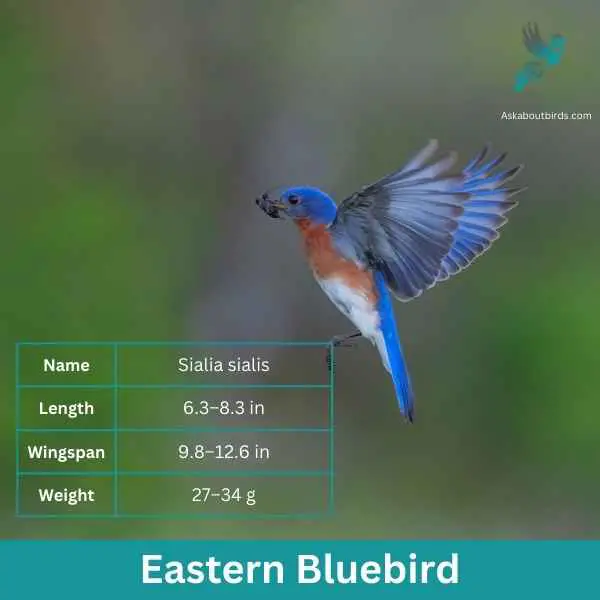
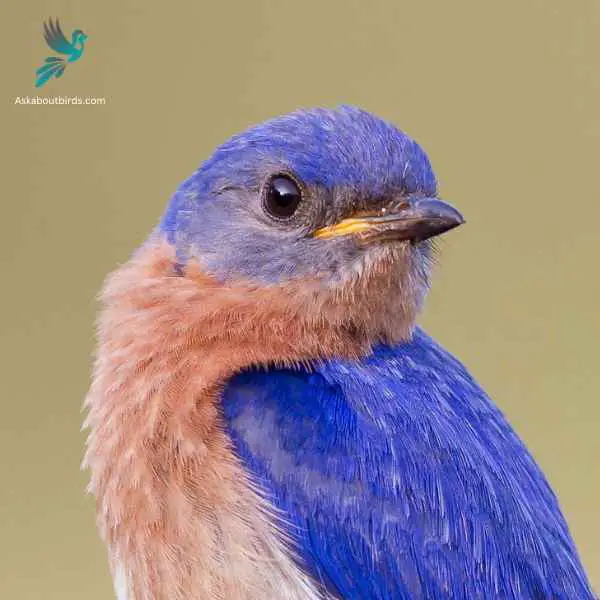
| Feature | Measurement |
|---|---|
| Scientific Name | Sialia sialis |
| Length | 6.3–8.3 in |
| Wingspan | 9.8–12.6 in |
| Weight | 27–34 g |
The Eastern Bluebird (Sialia sialis) is a small thrush found in open woodlands, farmlands, and orchards, and is recognized for its vibrant blue and red coloration. Male Eastern Bluebirds are dazzling with bright blue upperparts and a rusty or brick-red throat and breast, while females, though less colorful, still offer a similar pattern. The bird is native to North America and is commonly seen east of the Rockies, from Canada to the Gulf States and southeastern Arizona to Nicaragua.
Eastern Bluebirds feed on insects, wild fruit and berries. They have a gentle nature and are often seen perched alone or in small groups in the open, scanning the ground for prey. They are cavity nesters and will use old woodpecker holes or birdhouses if they are the right size.
Indigo Bunting


| Feature | Measurement |
|---|---|
| Scientific Name | Passerina cyanea |
| Length | 4.5–5.1 in |
| Wingspan | 7.1–9.1 in |
| Weight | 11.2–21.4 g |
The Indigo Bunting is a strikingly vibrant songbird, often hailed for its brilliant blue plumage and melodic song that graces woodlands and meadows during the warmer months.
Appearance: Males are renowned for their bright indigo blue feathers, which can appear darker in certain lights. Females and juveniles, on the other hand, are brown with subtle hints of blue on their wings and tail. The species lacks the vibrant streaking or spotting commonly found in many other songbirds.
Diet: Indigo Buntings primarily subsist on seeds, especially during non-breeding seasons. During the breeding season, they also consume a variety of insects such as beetles, caterpillars, and spiders, providing essential protein for their growing chicks.
Reproduction: Indigo Buntings build their nests close to the ground in shrubs or low tree branches. These nests, crafted meticulously with grasses and other plant materials, cradle clutches of typically 3 to 4 eggs. After hatching, the young are fed by both parents until they’re ready to fledge.
Western Bluebird
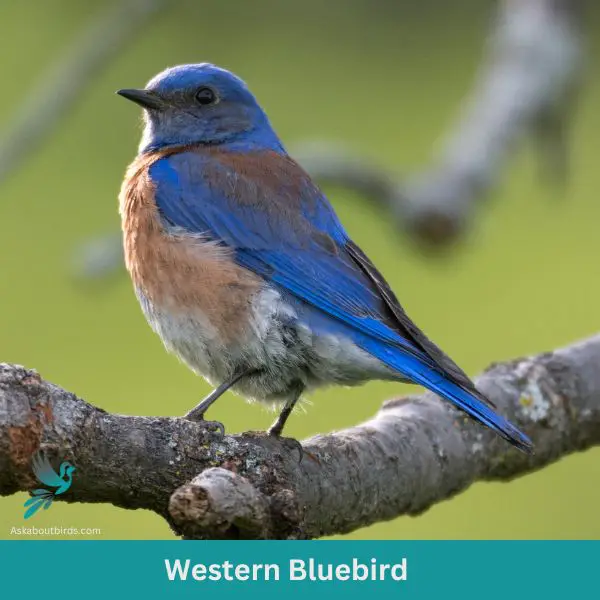
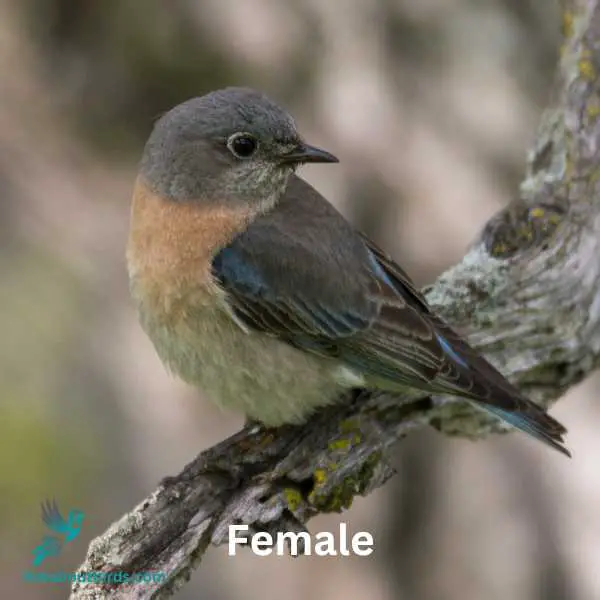
| Trait | Western Bluebird |
|---|---|
| Scientific Name | Sialia mexicana |
| Length | 5.5-7 inches |
| Wingspan | 11-13 inches |
| Weight | 0.8-1.1 ounces |
The Western Bluebird is a charismatic bird, appreciated for its vivid coloring and melodious song, commonly observed in open woodlands and meadows of the West.
Appearance: The male Western Bluebird sports a dark blue head, throat, wings, and tail with an orange breast and sides, transitioning into a grayish belly. Females are more muted, displaying grayish-blue wings and tail with a more subdued orange wash on the chest.
Diet: Western Bluebirds predominantly feed on insects, complemented by berries and fruits when available. They hunt by perching and then diving to the ground to capture their prey, and they’re also known to catch insects in mid-air.
Reproduction: These birds often utilize natural tree cavities or nest boxes for breeding. The female builds a loose nest inside and lays a clutch of 4-6 pale blue eggs.
Mountain Bluebird
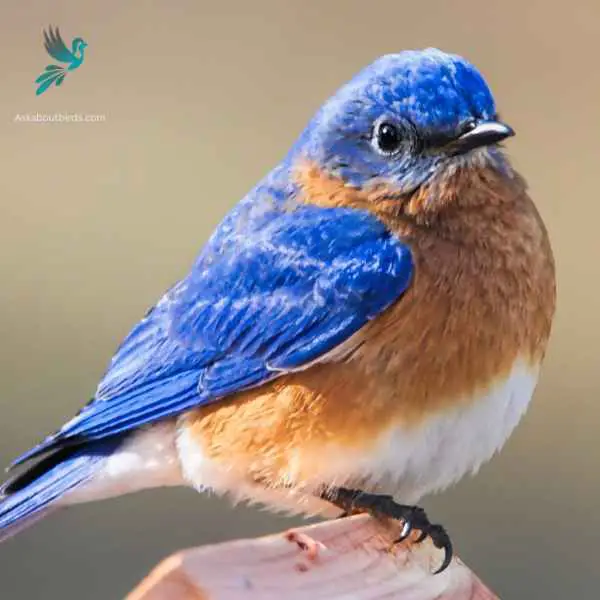
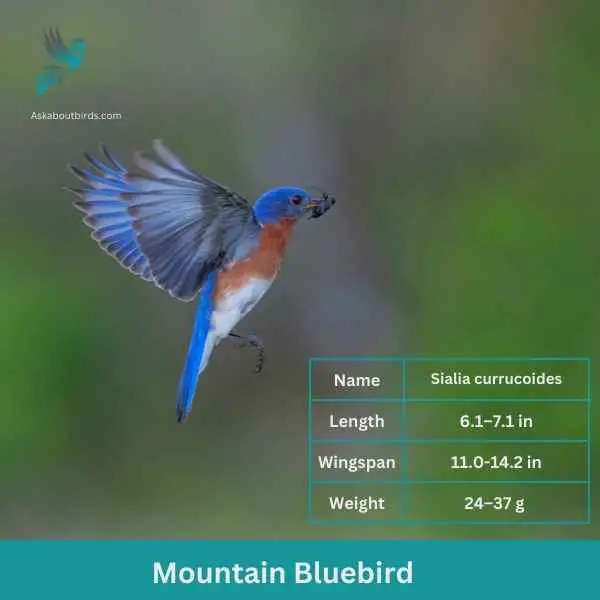
| Feature | Measurement |
|---|---|
| Scientific Name | Sialia currucoides |
| Length | 6.1–7.1 in |
| Wingspan | 11.0-14.2 in |
| Weight | 24–37 g |
The Mountain Bluebird is a small bird found in open grasslands and rocky mountains of North America. It is known for its stunning blue plumage, which is particularly vibrant in males. Females, on the other hand, have a more subdued blue coloration with hints of gray. These birds have slender bodies and a slightly curved bill, adapted for catching insects on the wing.
Mountain Bluebirds are insectivores, feeding primarily on insects such as beetles, grasshoppers, and spiders. They are skilled aerial hunters, capable of capturing their prey in mid-flight. During breeding season, these birds build their nests in tree cavities or man-made nest boxes, where females lay a clutch of eggs. The male bluebird actively participates in nest-building and provides food for the female during incubation.
Lazuli Bunting
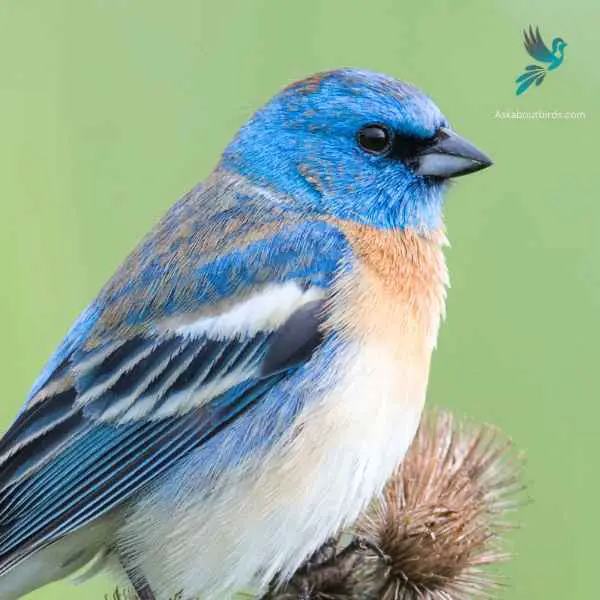

| Feature | Measurement |
|---|---|
| Scientific Name | Passerina amoena |
| Length | 5.1-5.9 in |
| Wingspan | 8.7 in |
| Weight | 13-18 g |
The Lazuli Bunting is a vibrant songbird recognized for its brilliant colors and melodious song, frequently seen in brushy areas and woodlands during the summer months.
Appearance: The male boasts a dazzling bright blue head and back, offset by a white belly and rust-orange breast. Females and immature birds present a more muted brownish hue overall, with a hint of blue on the wings and tail.
Diet: Lazuli Buntings primarily feed on seeds, but during the breeding season, they’ll also consume insects. Their strong, conical beaks are perfectly adapted for seed-cracking.
Reproduction: The female Lazuli Bunting constructs a cup-shaped nest using grasses, twigs, and other fine materials, often placing it in a shrub or low tree. She typically lays a clutch of 3-4 pale blue or white eggs.
Blue Jay

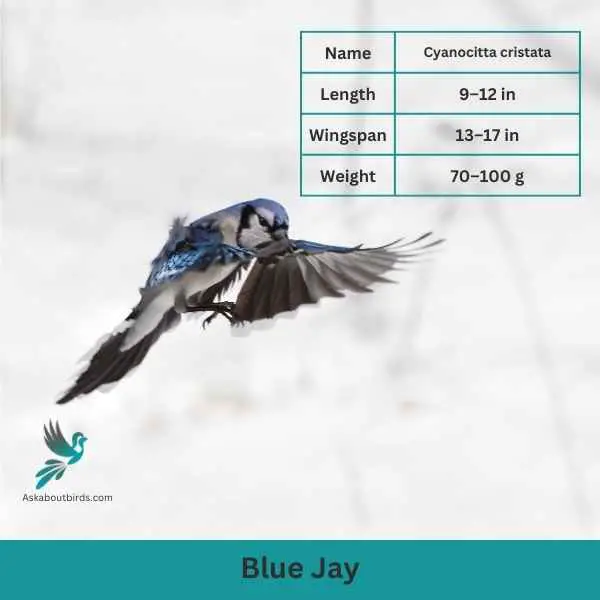
| Feature | Measurement |
|---|---|
| Scientific Name | Cyanocitta cristata |
| Length | 9–12 in |
| Wingspan | 13–17 in |
| Weight | 70–100 g |
The Blue Jay is a vibrant and easily recognized bird, known for its intelligence, distinctive calls, and bold behavior, commonly found throughout the eastern and central United States.
Appearance: The Blue Jay sports a striking blue upper body with white and black markings. Its face has a pronounced white patch with a black necklace that runs across the throat and around the head. The bird also features a pronounced blue crest, which can be raised or lowered, and its wings and tail are brightly colored with black bars and white tips.
Diet: Blue Jays are omnivores. Their diet consists primarily of seeds, nuts, especially acorns, fruits, and small insects. They’ve also been known to eat eggs or nestlings of other birds occasionally. Blue Jays often store food items in caches to eat later.
Reproduction: Blue Jays are monogamous birds that form long-lasting pair bonds. They typically build their nests in trees or large shrubs, constructing them from twigs, grass, and sometimes using mud as a binder. The female lays a clutch of 3 to 6 eggs, which are pale blue or sometimes white with brown speckles.
Steller’s Jay
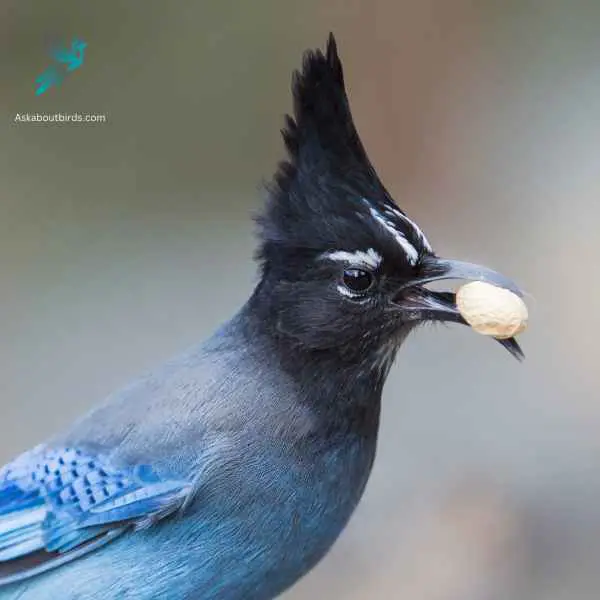

| Feature | Measurement |
|---|---|
| Scientific Name | Cyanocitta stelleri |
| Length | 12–13 in |
| Wingspan | 45 to 48 cm |
| Weight | 45 to 48 cm |
The Steller’s Jay is a charismatic and easily recognizable bird found mainly in the coniferous forests of the western North America, known for its bold behavior and loud, varied calls.
Appearance: The Steller’s Jay has a striking color contrast with a deep blue body and wings and a blackish head and upper body. One of its most distinguishing features is the tall, dark crest on its head, which can be raised or lowered depending on the bird’s mood. Its eyes are dark and its beak is strong and black.
Diet: The Steller’s Jay is omnivorous. It feeds on a wide range of items, from seeds, nuts, and berries to insects and small animals. It’s also known to raid campsites and picnics, often scavenging for human food.
Reproduction: Steller’s Jays form monogamous pairs that often remain together for several years. They typically build their nests in coniferous trees, made from twigs, moss, and other plant materials. The female lays a clutch of 2 to 6 eggs, which are usually pale green or blue with brown spots.
Barn Swallow


| Feature | Measurement |
|---|---|
| Scientific Name | Hirundo rustica |
| Length | 6.5–7.5 in |
| Wingspan | 12.5–13.5 in |
| Weight | 16–22 g |
The Barn Swallow is a sleek, agile bird renowned for its graceful flight patterns and iconic forked tail, often seen darting over fields and water bodies in search of flying insects.
Appearance: Barn Swallows have deep blue, almost iridescent, upperparts and a rufous to tawny underbelly. Their distinctively forked tail and long wings give them a streamlined look. Both males and females have a similar appearance, though males often exhibit slightly brighter colors and a deeper fork in the tail.
Diet: Barn Swallows feed primarily on flying insects, which they catch in mid-air during their agile and acrobatic flights. Their diet includes flies, beetles, moths, and other small flying insects.
Reproduction: Barn Swallows are known for building their mud nests on man-made structures, particularly barns, bridges, and eaves. The nest is cup-shaped and made from mud pellets, often lined with feathers. The female lays a clutch of 4 to 6 eggs.
Violet-green Swallow
Scientific Name: Tachycineta thalassina
Length: 4.7-5.1 in (12-13 cm)
Wingspan: 9.8-11.4 in (25-29 cm)
Weight: 0.4-0.6 oz (11-17 g)
The Violet-green Swallow is a small, agile bird known for its vibrant coloring and acrobatic flight skills.
Appearance: The male Violet-green Swallow has a bright, iridescent green back and head, and violet-blue wings and tail. The face, sides of the rump, and underparts are white. The female has a similar but duller coloration, with less iridescence on the back and head, and often a brownish tinge on the face and flanks.
Diet: Violet-green Swallows primarily feed on flying insects, which they catch in the air during their acrobatic flights. Their diet includes a wide variety of insects such as flies, wasps, ants, and beetles.
Reproduction: Violet-green Swallows typically nest in tree cavities, building nests, or cliff crevices. They often use old woodpecker holes or nest boxes provided by humans. The female lays a clutch of 4 to 6 white eggs, and both parents take turns incubating the eggs and feeding the chicks once they hatch.
Belted Kingfisher

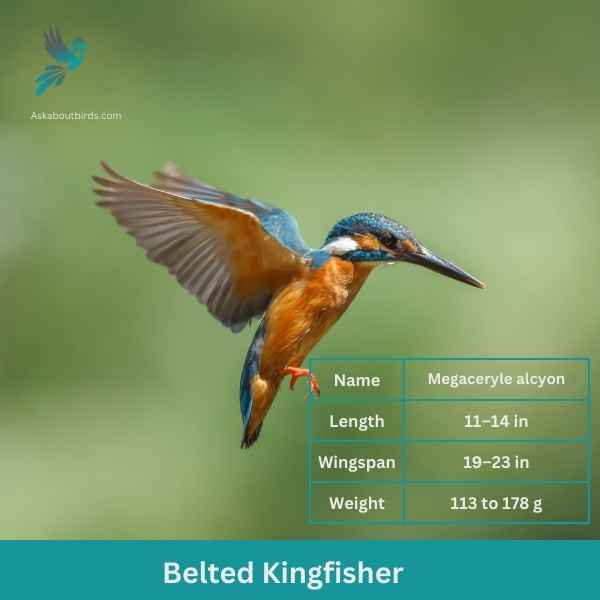
| Feature | Measurement |
|---|---|
| Scientific Name | Megaceryle alcyon |
| Length | 11–14 in |
| Wingspan | 19–23 in |
| Weight | 113 to 178 g |
The Belted Kingfisher is a distinctive and easily recognizable bird, frequently observed near water bodies, where it can be seen diving headfirst to catch prey.
Appearance: Sporting a prominent crest, the Belted Kingfisher has a slate blue-gray upper body and white underparts. Males possess a single blue band across their white chests, while females have an additional rufous band, making them one of the few bird species where females are more brightly colored than males. Their bill is long, sharp, and dagger-like.
Diet: As expert fishers, Belted Kingfishers mainly prey on small fish, but they’ll also consume crustaceans, insects, and amphibians. They’re known for their hunting tactic of hovering over water, spotting their prey, and then diving swiftly to snatch it.
Reproduction: Belted Kingfishers nest in burrows which they excavate in sandy or earthen banks, usually adjacent to water. The tunnel can be anywhere from 3 to 6 feet long, ending in a chamber. Within this chamber, the female lays a clutch of 5 to 8 white eggs.
Blue Grosbeak
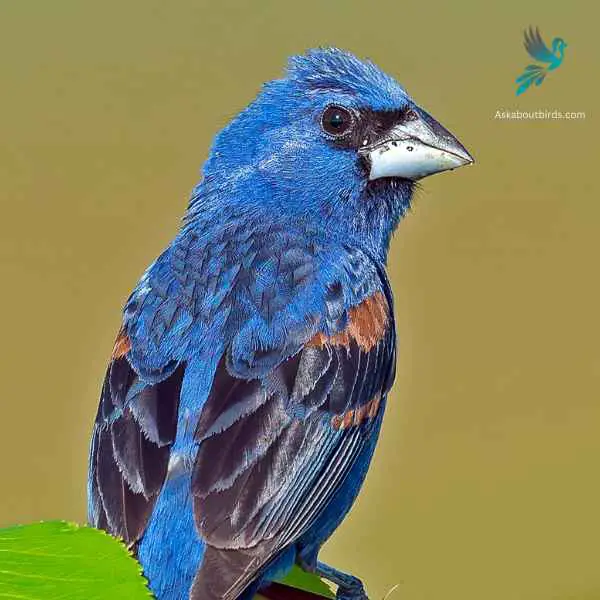

| Feature | Measurement |
|---|---|
| Scientific Name | Passerina caerulea |
| Length | 5.5 to 7.5 in |
| Wingspan | 10 to 11 in |
| Weight | 26 to 31.5 g |
The Blue Grosbeak is a medium-sized songbird found in North and Central America. The male Blue Grosbeak displays stunning plumage with deep blue feathers on its body and head, while the female has more subdued brownish tones. Both sexes have a thick, conical bill, which gives them their name “grosbeak,” meaning large beak.
These birds prefer open habitats such as grasslands, brushy areas, and woodland edges. Blue Grosbeaks are known for their melodious songs, which consist of a series of rich and varied notes. They primarily feed on seeds and insects, using their strong beaks to crack open seeds and forage on the ground or in low vegetation.
Where to Spot Washington’s Blue Birds
Being a devoted birdwatcher with a particular affection for blue birds, I have ventured across the stunning landscapes of Washington state, pinpointing several locations renowned for their bird diversity. Here are the top 5 spots, carefully curated, that boast the greatest assortment of birds, including an array of blue bird species:
- Nisqually National Wildlife Refuge: Located near Olympia, this refuge is a haven for birdwatchers. With its diverse habitats of estuaries, freshwater marshes, open water, and forested uplands, it attracts a wide variety of bird species, including the Western Bluebird.
- Spokane River Centennial Trail: This trail stretches for miles along the Spokane River and offers a variety of habitats for birds. Keep an eye out for Mountain Bluebirds in the open areas and riparian zones.
- Mount Rainier National Park: This iconic national park offers a variety of habitats from lowland forests to subalpine meadows. The park is home to a diverse range of birds, including the stunning Steller’s Jay.
- San Juan Islands: The diverse habitats of these islands attract a variety of bird species. Look out for the vibrant Western Bluebird and the striking Belted Kingfisher.
- Ridgefield National Wildlife Refuge: Located in the Columbia River floodplain, this refuge offers a mix of habitats, including wetlands, grasslands, and woodlands. It is a great spot to see the Western Bluebird and the Tree Swallow.
| Neighboring State | Best Spots for Blue Birds |
|---|---|
| Oregon’s Blue birds | 1. Malheur National Wildlife Refuge 2. Mount Hood National Forest 3. Crater Lake National Park |
| Idaho’s Blue birds | 1. Coeur d’Alene National Forest 2. Sawtooth National Recreation Area 3. Boise National Forest |
FAQs on Blue Bird Species Found in Washington
What are the common blue colored birds found in Washington State?
Washington State is home to a variety of blue colored birds. One common species is the Western Scrub Jay, a stocky bird with a blue head, wings, and tail, a gray belly, and a white throat with a blue necklace. Another common blue colored bird is the Red-breasted Nuthatch, which has a blue back and wings, a reddish chest, and a white throat with a black head stripe. The Pinyon Jay, another blue bird found in Eastern Washington, has a mostly blue body with a lighter gray belly. Additionally, the Black-throated Blue Warbler, a migratory bird with black wings, a black head, and a blue back, can also be found in Washington State during its migration. Lastly, the Purple Martin, a migratory bird with a dark blue-purple body, can be found nesting in natural cavities or nest boxes during the breeding season in both Western and Eastern Washington.
What do blue colored birds eat?
Blue colored birds, like the Western Scrub Jay and the Purple Martin, have varied diets that include both animal and plant matter. Western Scrub Jays primarily eat insects, small fruits, and seeds, including sunflower seeds and acorns. They are also known to eat other birds’ eggs and young birds. Purple Martins primarily eat insects caught in flight, but will also consume small fruits during the non-breeding season. The Red-breasted Nuthatch primarily feeds on insects found in tree bark, but will also consume seeds and small fruits. Providing bird feeders with sunflower seeds and white proso millet can attract these blue colored birds to your backyard.
What habitats do blue colored birds prefer?
Blue colored birds can be found in a variety of habitats across Washington State and Eastern North America. The Western Scrub Jay is typically found in mixed forests with scattered trees and shrubs, as well as in urban and suburban areas. The Purple Martin prefers open areas near water, where insect populations are abundant. They nest in cavities, either natural or provided by humans in the form of nest boxes. The Red-breasted Nuthatch is commonly found in coniferous and mixed forests. The Black-throated Blue Warbler prefers deciduous forests, especially during the breeding season, while the Pinyon Jay is found in pinyon-juniper woodlands and other open, dry habitats.
What are some tips for attracting blue colored birds to your backyard?
Attracting blue colored birds such as the Western Scrub Jay, Red-breasted Nuthatch, Purple Martin, and Tree Swallow to your backyard involves several steps. First, provide food by setting up bird feeders filled with sunflower seeds and white proso millet, favorites of many blue birds. Next, provide water through a bird bath or shallow water source, and nesting sites by installing nest boxes suitable for cavity-nesting birds. Planting native vegetation, trees, and shrubs that produce small fruits and berries will provide a natural food source. Lastly, maintain a safe environment by keeping cats indoors, being mindful of window collisions, and placing feeders and baths at a safe distance from windows and potential predators.

